City Dai, Country Dai—Regional Differences in Yunnan’s Dai Cuisines
July 19th, 2013

This article about two of my favorite restaurants in Yunnan—and how their different dishes showcase the different styles of Dai food available in the province—was first published in the food journal the Art of Eating, Issue 90, in September of 2012. Josh provided the photography for the article, and I’ve included even more of his lovely photographs from those photo shoots here.
Yunnan, China: City Dai, Country Dai
To reach Yingjiang-Style Dai Flavor Restaurant, you take a small ramp that runs between a convenience store and a construction site and turn in at a door with a small banner hung over it. The restaurant is a warren of cramped rooms that have been spruced up with romantic photos of the Chinese countryside, wainscoting of woven bamboo, and a little bamboo “roof” over each doorway. A few tables are also spread out along the white tiled walls of a courtyard in the center of the building, which the restaurant shares with a dumpling restaurant, a mahjong parlor, and a couple of pool tables.
Originally, the restaurant was in a much more charming location half a block away. That storefront was faced in the pretty bamboo siding that usually marks Dai restaurants in Kunming, a city of six million that is the capital of Yunnan Province. The location and a few low bamboo tables, curling out along the sidewalk and into a nearby alley, created a lively, friendly atmosphere. That’s what first drew me to the restaurant when I moved into an apartment across the street, but the food keeps me coming even in the new spot.
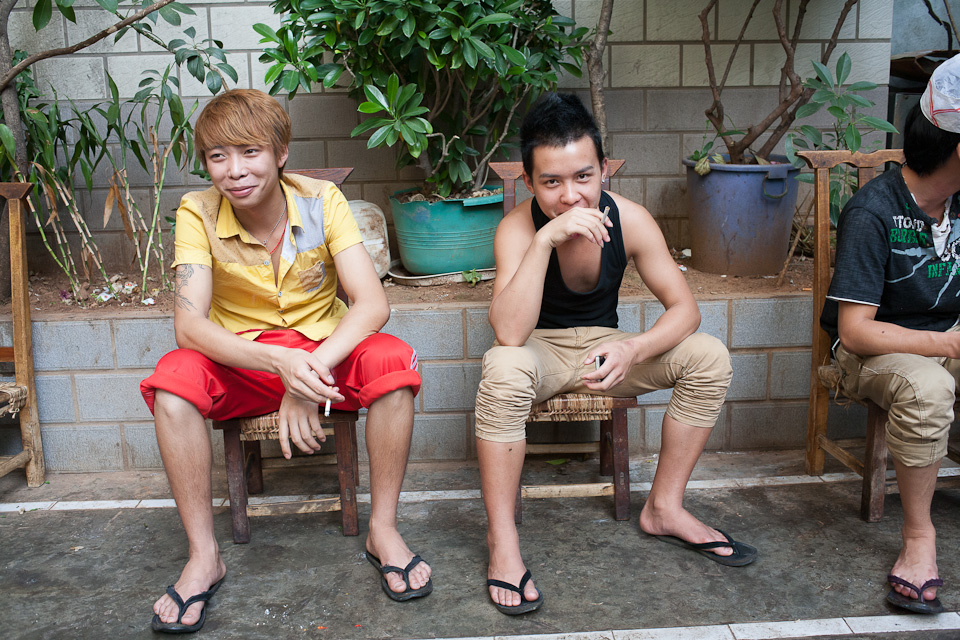
Cooks at Yinjiang Dai Wei Yuan relax between the lunch and dinner rushes
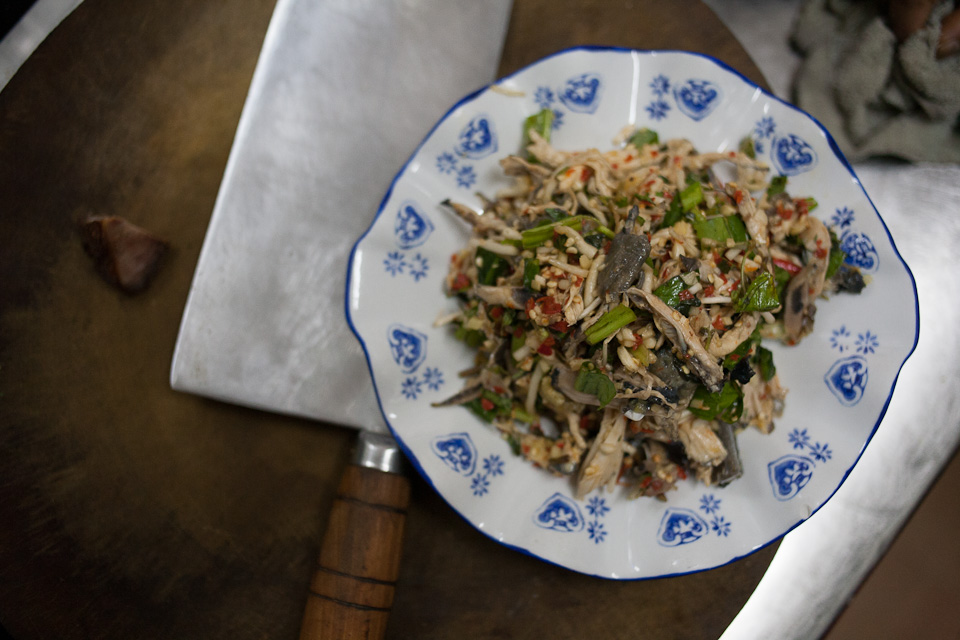
“Ghost chicken” with herbs, chile, and lime
Dai food is often called the Thai food of China, but this describes its origins rather than its flavors. The Dai live in the southern and western parts of Yunnan (China’s southwesternmost province) and are the descendents of the Tai, or Bai Yue, a people who lived in western China, Burma, Laos, and parts of eastern India before migrat- ing south to Thailand around the first century ad. That makes them cousins of the modern-day Thai, and some of their culinary traditions are similar to those of northern Thailand and Laos.
Meng Mingchun, the owner of Yingjiang Dai Wei Yuan, is from Yingjiang County in westernmost Yunnan, on the border of the Burmese state of Kachin, and her restaurant’s dishes all come from the rich cuisine of that region. To ensure the food’s authenticity, she brought a cadre of cooks with her. She also imported the restaurant’s defining characteristic: its gaggle of waitresses, a sisterhood of girls in their teens — dressed in brightly colored traditional Dai skirts and modern ruffled T-shirts, their hair, often bleached to an ungodly orange, tied on their heads in sloppy buns — who give indifferent service.

The waitresses are all from the owner’s hometown
The restaurant boasts one of those Chinese menus that lists page after page of dishes, though fortunately for me and any other foreign visitor this one features both photos and strange English translations. It starts with barbecued dishes like sliced pork belly and grilled chicken, then has a page of foods cooked in banana leaves, and then a couple of dozen cold dishes, ranging from cucumber salad to cold noodles to a plate of sliced preserved eggs. After these come deep-fried dishes, such as pork ribs, deep-fried dried beef, and slices of fried lotus root coated in egg batter (mysteriously translated as “Dai taste fried coupling”). Last, there is a tremendous variety of stir-fries, soups, and stews, many of them featuring ground meat.
Despite the length of the menu, all the food clearly reflects the few, simple flavors and cooking techniques that are the building blocks of Dai cuisine. First and most basic is the liberal use of fresh herbs and chiles, often combined with lime juice or rice vinegar. (It’s a powerful combination, especially if you’re not accustomed to Southeast Asian-style spiciness.) A dish of shred- ded black-skinned chicken is served cold and dressed with minced garlic and ginger, chopped sawtooth herb, fish mint root (a crunchy, hollow root with a flavor similar to cilantro), a hefty dose of lime juice, and searingly spicy, fresh Thai chiles. Something called “lemon caesar” is actually a plate of rice noodles topped with boiled tripe and slices of roast beef heart, and it comes with a bowl of lime juice, ground pork, chopped chiles, and cilantro, which serves as a flavor- ful dip. The herbs of some dishes even constitute the main ingredient, as in a salad of mint sprigs mixed with thin slices of onion and tomato and dressed with copious amounts of chopped chile and vinegar.
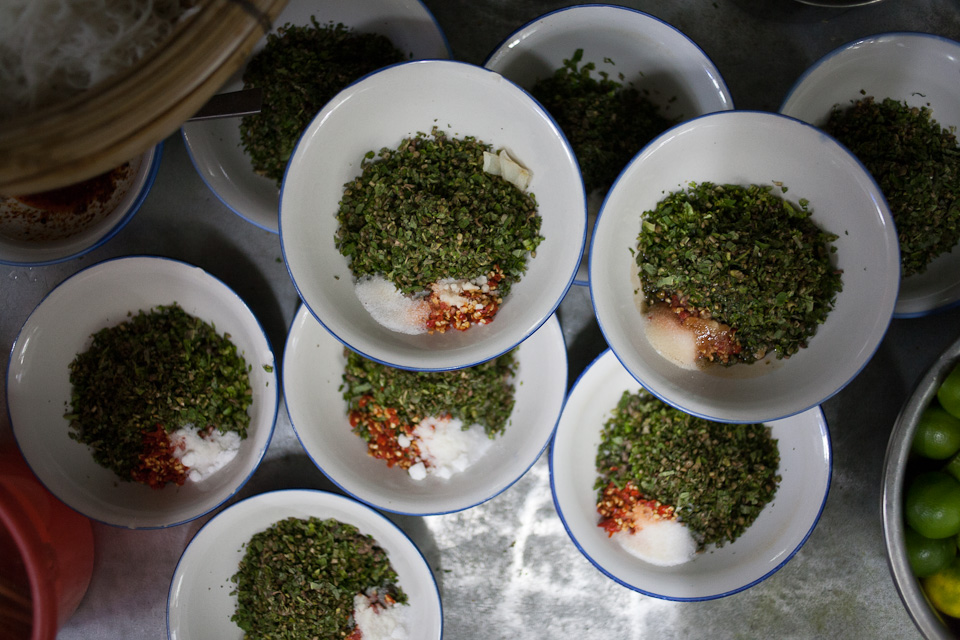
Bowls of herbs, chile, and salt, pre-prepared for noodle dipping sauce
The second key element of Dai cooking is grilling, and many of the dishes come from the gas grill that Ms. Meng installed in a narrow room to the side of the kitchen. Here strips of chile-coated pork belly are cooked until they develop a smoky, crunchy crust, and small chickens are grilled with nothing more than a bit of lem- ongrass. Grilling even provides the essential flavor in a salad of blackened, wilted, cold eggplant and bell pepper. Though the vegetables’ skins have been removed and their flesh has been flavored with garlic, rice vinegar, soy sauce, fresh chiles, and cilantro, the smokiness sings through.
The readily apparent third feature of Dai cooking is tropical ingredients. Pickled bamboo shoots impart a unique sour, lemony, and slightly funky flavor to a stir-fry of finely chopped beef and tomatoes. Banana flowers sliced in thin strips are treated as a vegetable and stir-fried with a sweet mixture of tomato, bell pepper, garlic, and dried chiles, until they achieve a toothsome leeklike texture. Banana leaves are folded around flavorful ingredients like Chinese watercress or chicken livers and grilled until they are black; though you don’t eat them, they imbue the fillings with a subtle vegetal flavor. And pineapple is used in the iconic Dai dish boluo fan (“pineapple rice”), a combination of sticky rice, fresh pineapple, and banana with a dessertlike sweetness that handily cuts the spiciness of the restaurant’s more fiery dishes (the Chinese don’t separate sweet and savory).

Stir-frying banana flowers with tomatos and peppers
Meals at the restaurant, depending on the number of guests at the table, usually include one or more dishes from each section of the menu and are rounded out with baskets of steamed white rice. The waitresses pour every- one small cups of pu’er tea, and many patrons also order large bottles of pale, insipid Chinese beer or individual glasses of made-to-order limeade.
Although dessert is not typically part of Chinese meals, for those craving a sweet ending the restaurant does offer one suitable, soothing dish — a bowl containing tapioca, clear Jell-O-like jelly, milk, toasted bread, sweetened condensed milk, and dried coconut. The concoction is a fusion of Asian and Western cooking traditions (Ms. Meng posits that it probably came from post-colonial Burma), but the cool, sweet flavors are a perfect addition to a Dai meal. “It’s a tradi- tional dish where we come from,” explained one of the waitresses as she made me a bowl of the stuff recently. “It’s probably a new tradition, but now it’s our tradition.”
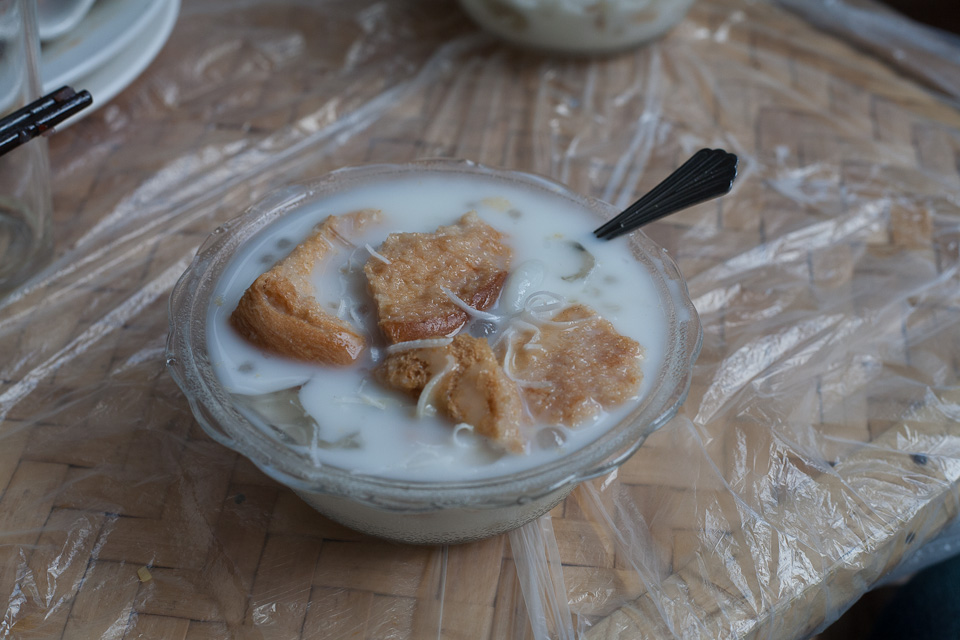
A Burmese-influenced dessert of bread, tapioca, and milk
* * *

Mi Zhuang grilling behind the Red Bean Garden Fish Farmstead restaurant
Nestled at the edge of a banana plantation near Yunnan’s southern- most point , just 44 kilometers from the border with Laos and Burma, Red Bean Garden Fish Farmstead is a world away from the crowded metropolis of Kunming. The restaurant is a simple room with a bare concrete floor, a peaked corrugated polycarbonate roof, and, in place of walls, widely spaced green concrete pillars shaped like bamboo stalks. Behind the dining room are two large fishponds, and in front of it is a small dirt and gravel lot that is designed for parking but is usually taken over by a flock of baby chicks.
In this quiet setting, Mi Zhuang, 48, a retired rural healthcare worker, serves a pared-down menu of Dai specialties to groups of locals and the occasional party of expat biologists who drive over from the nearby Xishuangbanna Tropical Botanical Garden research institute. In fact, to say that there is a menu at all is misleading. Rather than formalize her offerings in written form, Mrs. Mi simply makes whatever dishes are in season. Guests call ahead to let her know they’re coming, and, unless they have something specific to request, they just tell her how many people will be in their party and she makes a variety of foods appropriate to the occasion. With very few exceptions, these are the same rustic, homey dishes that she makes for her own family, the ones made by her mother and grandmother before her.

Dinner at Red Bean Garden Fish Farmstead restaurant
The food here in the Xishuangbanna Dai Autonomous Region is a bit simpler than the Yinjiang-style food of the restaurant in Kunming. It relies yet more heavily on grilling, and it is sea- soned with a more basic mix of herbs, usually a combination of cilantro, sawtooth herb, and fresh bird’s-eye chiles, with an occasional addition of lemongrass or scallion greens. “I think the way the food is made here comes from being in the forest,” explains Mi Zhuang’s daughter, Yi Zhuangfang, a biologist who studied for her Ph.D. at the research center. “Because you just collect some ingredients from the forest, and then you find banana leaves and clean everything in the river, and wrap it and put it into the fire. You don’t need to carry anything with you.”
Mrs. Mi’s kitchen, visible through the open walls of the dining room, is sparse and utilitarian. Long and narrow, it is bordered on three sides by concrete-block walls that stop a good two feet below the corrugated roof, letting in light and air and keeping the space cool in the tropical heat. One of the two long walls is lined with mismatched cabinets that hold plates and utensils, while the other is taken up by a wood and tile counter and a deep sink. On the short back wall, farthest from the diners, two burners are fueled by a large propane tank.
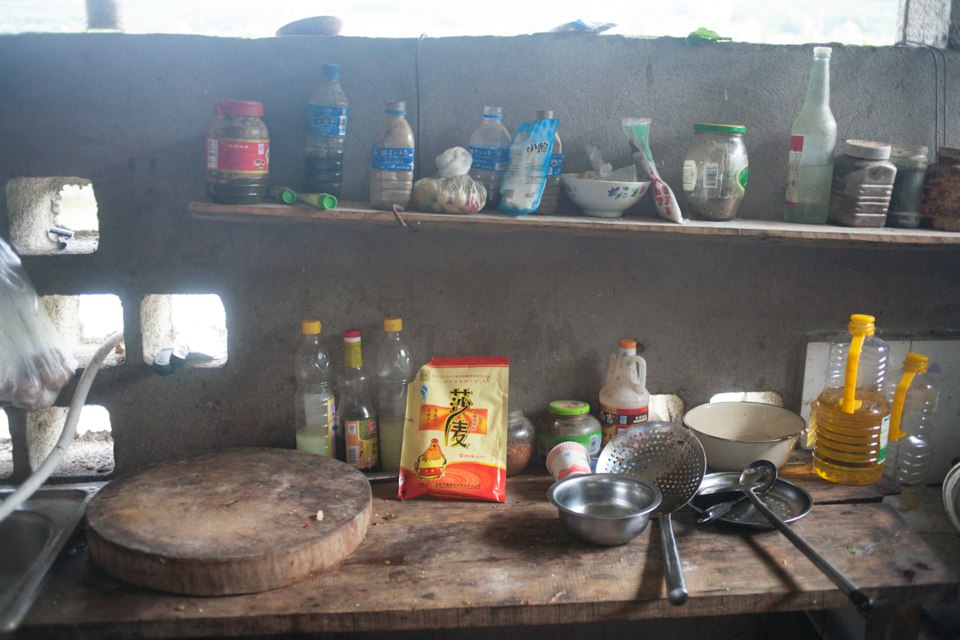
Mi Zhuang’s kitchen
On these Mrs. Mi prepares a few dishes best made with a modern source of heat. She dips slices of thin, green- tinged Asian eggplant in an egg-and- potato-starch batter and deep-fries them until they become meltingly tender inside a soft crust. She gives leafy greens, such as sweet potato leaves, the same treatment but cooks them until they come out crisp and crunchy. Thin squares of “river weed”—algae gathered from the Mekong River and pressed into sheets, like paper—are fried on their own until crisp. (The same preparation is popular in the adjacent part of Laos, a few miles to the south.) She chops fresh pork until it looks as though it has been passed through a grinder, then mixes it with the herb and chile mixture, some garlic, chopped scallion greens, and a couple cups of water—just enough to poach the meat in. This mild dish is called dousheng, or “chopped fresh” meat; it was eaten raw until a couple decades ago, when the Chinese government began to educate rural people about the dangers of food poisoning.
Apart from those few items, the real cooking is done outside, next to the dining room, on a small deck of uneven wooden planks that stretches out over the fishponds. Three huo tang—low, round cement pots approximately 18 inches high and a foot in diameter—hold small wood fires. Here on metal grates, next to heating kettles and pots, Mrs. Mi grills most of the dishes she serves. “People used to just put a big stone on its end and make a fire around it, and cook on that,” says Yi Zhuangfang. “Then after a while they used a metal ring, with feet, and now everyone uses this kind of stove. It holds the heat better.”
Nearly all meals at the restaurant include a serving of fish from the restaurant’s ponds. Mrs. Mi scales and cleans tilapia, cutting them open along the spine and leaving the bones and tender stomach meat intact; she salts the cavities, stuffs them with herbs and chiles, then closes the fish back up before placing them in a small grilling cage, about a foot square and an inch thick, which she uses to hold everything in place over the huo tang. As the tilapia cook slowly over the coals, Mrs. Mi brushes the skin with vegetable oil mixed with salt, turning the grilling cage every few minutes until the fish’s flesh is perfumed with the herbs and the skin is crisp. Most meals also include a serving of dried beef, a popular Dai specialty. Mrs. Mi cuts the raw meat into long strips, coating them with salt and dried chile, and leaving them in the sun until they are thoroughly dried, usually two days. She grills this, too, for a few minutes, to bring out its flavor and add a touch of smoke, then shreds the meat, making threads so fine that they have almost the texture of beef-flavored cotton candy.
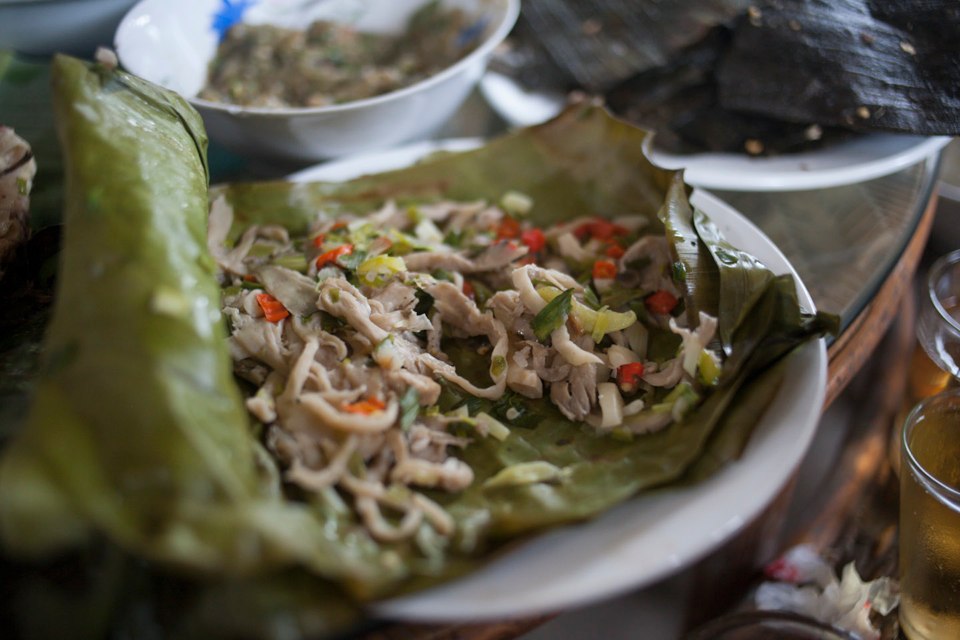
Mushrooms with herbs and chiles grilled in a banana leaf
For larger parties, Mrs. Mi also serves small native Chinese chickens, culling them from the flock that wanders the restaurant’s grounds at will, disappearing during the day to forage for insects in the nearby banana groves. After cleaning them, she splits them open along the sternum and butterflies them, stuffs the interior cavity with herbs and chiles, and folds the greens of a stalk of lemongrass into a zigzag screen to keep the filling from falling out. She roasts each bird over low heat in the grilling cage, flipping it over every few minutes to ensure slow, even cooking and stabbing the fattier parts of the thigh and legs repeatedly with a sharpened chopstick to let the fat run out. The resulting meat is tender, covered by crisp skin, and thoroughly perfumed with the fragrance of the herbs.
Given the restaurant’s location in the middle of a banana grove, it’s not surprising that Mrs. Mi also cooks many foods in banana-leaf packages. But instead of using richly flavored ingredients, she sticks with slices of fish or mushrooms, which, when seasoned with the herb-chile mix and grilled slowly, take on more of the leaves’ vegetal flavor.
Mrs. Mi also makes good use of the Dai technique of pounding foods in a large wooden mortar and pestle. A spicy salad of cucumbers flavored with the herb-chile mixture and drenched in lime juice is topped by a handful of roughly pounded peanuts. Fresh slices of cucumber and boiled, bitter spears of banana “stem” (the white, fibrous vegetable cut from the center of a banana tree stalk) are served with a dipping sauce of roasted tomatoes, fresh chiles, and a few pieces of cilantro that have been pounded together until almost liquid. Even roasted eggplant is peeled and pounded with the herb-chile mix until it takes on a smooth, comforting texture.
By the time guests arrive, Mrs. Mi has finished making most of these dishes and has laid them out on the restaurant’s low tables, woven of bamboo and reeds and topped with glass lazy susans. A few baskets of white sticky rice round out the meal, along with a plate of fresh mint to eat with the dousheng pork, fresh tea, and perhaps a serving of pineapple rice, served in the hollowed-out fruit. Guests bring their own beer, often cases of tall 500-milliter bottles. Each dish is simple and straightforward, and the ingredients don’t really vary all that much from dish to dish. And yet somehow, altogether, the combination and the way the ingredients mix with the strong, bright flavors of the herbs and spices, produces a meal so varied and interesting that the more you eat the food, the more you crave it.
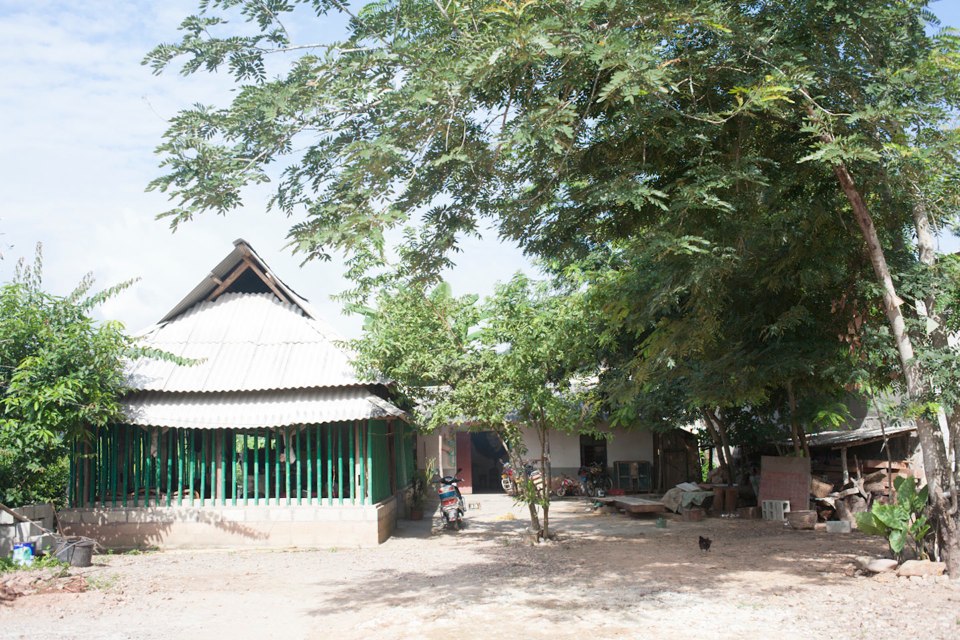
Yingjiang Dai Wei Yuan
(“Yingjiang-Style Dai Flavor Restaurant”)
69 Luofeng Street, near the corner of Luofeng, Yuantong, and Beimen streets
Kunming, Yunnan
0871-512-2251
Hong Dou Yuan Yu Zhuang
(“Red Bean Garden Fish Farmstead”)
Just past the village of Man’e, 2.7 km west of Menglun on national road 213
Mengla County, Xishuangbanna, Yunnan
135-7810-0925



